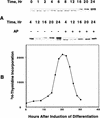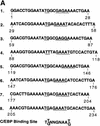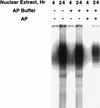Activation and centromeric localization of CCAAT/enhancer-binding proteins during the mitotic clonal expansion of adipocyte differentiation
- PMID: 10485846
- PMCID: PMC316997
- DOI: 10.1101/gad.13.17.2231
Activation and centromeric localization of CCAAT/enhancer-binding proteins during the mitotic clonal expansion of adipocyte differentiation
Abstract
Hormonal induction of 3T3-L1 preadipocytes triggers a cascade of events that initiate differentiation into adipocytes. CCAAT/enhancer-binding proteins beta and delta (C/EBPbeta/delta) are expressed early in the differentiation program, but are not immediately active. After a long lag, C/EBPbeta/delta become competent to bind to the C/EBP regulatory element in the C/EBPalpha gene promoter, C/EBPalpha being a transcriptional activator of numerous adipocyte genes. As C/EBPbeta/delta acquire binding activity, they become localized to centromeres as preadipocytes synchronously enter S phase at the onset of mitotic clonal expansion. Localization to centromeres occurs through C/EBP consensus-binding sites in centromeric satellite DNA. C/EBPalpha, which is antimitotic, becomes centromere-associated much later in the differentiation program as mitotic clonal expansion ceases and the cells become terminally differentiated.
Figures



















Similar articles
-
Role of the CCAAT enhancer binding proteins (C/EBPs) in adipocyte differentiation.Biochem Biophys Res Commun. 1999 Dec 29;266(3):677-83. doi: 10.1006/bbrc.1999.1885. Biochem Biophys Res Commun. 1999. PMID: 10603305 Review.
-
Dominant-negative C/EBP disrupts mitotic clonal expansion and differentiation of 3T3-L1 preadipocytes.Proc Natl Acad Sci U S A. 2004 Jan 6;101(1):43-7. doi: 10.1073/pnas.0307229101. Epub 2003 Dec 19. Proc Natl Acad Sci U S A. 2004. PMID: 14688407 Free PMC article.
-
Sequential repression and activation of the CCAAT enhancer-binding protein-alpha (C/EBPalpha ) gene during adipogenesis.Proc Natl Acad Sci U S A. 2000 Nov 7;97(23):12519-23. doi: 10.1073/pnas.220426097. Proc Natl Acad Sci U S A. 2000. PMID: 11050170 Free PMC article.
-
Role of C/EBP homologous protein (CHOP-10) in the programmed activation of CCAAT/enhancer-binding protein-beta during adipogenesis.Proc Natl Acad Sci U S A. 2000 Nov 7;97(23):12446-50. doi: 10.1073/pnas.220425597. Proc Natl Acad Sci U S A. 2000. PMID: 11050169 Free PMC article.
-
Control of adipocyte differentiation by CCAAT/enhancer binding protein alpha (C/EBP alpha).Int J Obes Relat Metab Disord. 1996 Mar;20 Suppl 3:S91-6. Int J Obes Relat Metab Disord. 1996. PMID: 8680485 Review.
Cited by
-
Gene expression and characterization of clonally derived murine embryonic brown and brite adipocytes.FEBS Open Bio. 2024 Sep;14(9):1503-1525. doi: 10.1002/2211-5463.13861. Epub 2024 Jul 7. FEBS Open Bio. 2024. PMID: 38972757 Free PMC article.
-
Human sat III and Drosophila hsr omega transcripts: a common paradigm for regulation of nuclear RNA processing in stressed cells.Nucleic Acids Res. 2006;34(19):5508-14. doi: 10.1093/nar/gkl711. Epub 2006 Oct 4. Nucleic Acids Res. 2006. PMID: 17020918 Free PMC article. Review.
-
Prevention of CCAAT/enhancer-binding protein beta DNA binding by hypoxia during adipogenesis.J Biol Chem. 2010 Jan 29;285(5):3289-99. doi: 10.1074/jbc.M109.059212. Epub 2009 Nov 25. J Biol Chem. 2010. PMID: 19940121 Free PMC article.
-
CCAAT/enhancer-binding proteins: structure, function and regulation.Biochem J. 2002 Aug 1;365(Pt 3):561-75. doi: 10.1042/BJ20020508. Biochem J. 2002. PMID: 12006103 Free PMC article. Review.
-
Forkhead transcription factor Foxo1 is essential for adipocyte differentiation.In Vitro Cell Dev Biol Anim. 2009 Dec;45(10):642-51. doi: 10.1007/s11626-009-9230-5. In Vitro Cell Dev Biol Anim. 2009. PMID: 19585174
References
-
- Baer M, Williams SC, Dillner A, Schwartz RC, Johnson PF. Autocrine signals control CCAAT/enhancer binding protein β expression, localization and activity in macrophages. Blood. 1998;92:4353–4365. - PubMed
-
- Bernlohr DA, Bolanowski MA, Kelly TJ, Lane MD. Evidence for an increase in transcription of specific mRNAs during differentiation of 3T3-L1 preadipocytes. J Biol Chem. 1985;260:5563–5567. - PubMed
-
- Brun RP, Tontonoz P, Forman BM, Ellis R, Jasmine C, Evans RM, Spiegelman BM. Differential activation of adipogensis by multiple PPAR isoforms. Genes & Dev. 1996;10:974–984. - PubMed
-
- Cao Z, Umek RM, McKnight SL. Regulated expression of three C/EBP isoforms during adipose conversion of 3T3-L1 cells. Genes & Dev. 1991;5:1538–1552. - PubMed
Publication types
MeSH terms
Substances
LinkOut - more resources
Full Text Sources
Other Literature Sources
Research Materials
